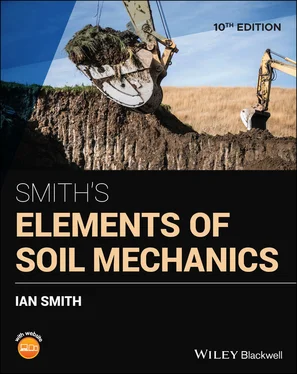1 ...6 7 8 10 11 12 ...29 The identification of rocks may, initially, be considered quite a tricky thing to get right. With practice and experience however, engineers and geologists can rapidly identify features, that enable the identification to be made swiftly. Features, which assist in the identification and description of the rock type, include colour, grain size, mineralogical composition, structure and void content. Guidance on the identification and description of rock types is given in BS EN ISO 14689 (BSI, 2018b) and in the Code of practice for ground investigations , BS 5930 (BSI, 2015).
The actions of frost, temperature, gravity, wind, rain and chemical weathering are continually forming rock particles that eventually become soils. There are three types of soil when considering modes of formation.
Transported soil (gravels, sands, silts and clays)
Many soils have been transported by water. As a stream or river loses its velocity, it tends to deposit some of the particles that it is carrying, dropping the larger, heavier particles first. Hence, on the higher reaches of a river, gravel and sand are found whilst on the lower or older parts, silts and clays predominate, especially where the river enters the sea or a lake and loses its velocity. Ice, in the form of huge slow‐moving yet enormously powerful glaciers, is another important transportation agent, and large deposits of boulder clay and moraine are formed from glaciation .
In arid parts of the world, wind is continually forming sand deposits in the form of ridges. The sand particles in these ridges have been more or less rolled along and are invariably rounded and fairly uniform in size. Light brown, wind‐blown deposits of silt‐size particles, known as loess , are often encountered in thin layers, the particles having sometimes travelled considerable distances.
Residual soil (topsoil, laterites)
These soils are formed in situ by chemical weathering and may be found on level rock surfaces where the action of the elements has produced a soil with little tendency to move. Residual soils can also occur whenever the rate of break‐up of the rock exceeds the rate of removal. If the parent rock is igneous or metamorphic the resulting soil sizes range from silt to gravel.
Laterites are formed by chemical weathering under warm, humid tropical conditions when the rainwater leaches out of the soluble rock material leaving behind the insoluble hydroxides of iron and aluminium, giving them their characteristic red‐brown colour.
These soils contain large amounts of decomposed animal and vegetable matter. They are usually dark in colour and give off a distinctive odour. Deposits of organic silts and clays have usually been created from river or lake sediments. Peat is a special form of organic soil and is a dark brown spongy material, which almost entirely consists of lightly to fully decomposed vegetable matter. It exists in one of three forms:
Fibrous: non‐plastic with a firm structure only slightly altered by decay.
Pseudo‐fibrous: peat in this form still has a fibrous appearance but is much softer and more plastic than fibrous peat. The change is due more to prolonged submergence in airless water than to decomposition.
Amorphous: with this type of peat, decomposition has destroyed the original fibrous vegetable structure so that it has virtually become an organic clay.
Peat deposits occur extensively throughout the world and can be extremely troublesome when encountered in civil engineering work.
1.2.3 Granular and cohesive soils
Geotechnical engineers classify soils as either granular or cohesive . Granular soils (sometimes referred to as cohesionless soils) are formed from loose particles without strong inter‐particle forces, e.g. sands and gravels. Cohesive soils (e.g. clays, clayey silts) are made from particles bound together with clay minerals. The particles are flaky and sheet‐like and retain a significant amount of adsorbed water on their surfaces. The ability of the sheet‐like particles to slide relative to one another, gives a cohesive soil the property known as plasticity .
Rock fragments can be reduced by mechanical means to a limiting size of about 0.002 mm, so that a soil containing particles above this size has a mineral content similar to the parent rock from which it was created.
For the production of particles smaller than 0.002 mm, some form of chemical action is generally necessary before breakdown can be achieved. Such particles, although having a chemical content similar to the parent rock, have a different crystalline structure and are known as clay particles. An exception is rock flour, rock grains smaller than 0.002 mm, produced by the glacial action of rocks grinding against each other.
1.3.1 Classes of clay minerals
The minerals constituting a clay are invariably the result of the chemical weathering of rock particles and are hydrates of aluminium, iron or magnesium silicate generally combined in such a manner, as to create sheet‐like structures only a few molecules thick. These sheets are built from two basic units, the tetrahedral unit of silica and the octahedral unit of the hydroxide of aluminium, iron or magnesium. The main dimension of a clay particle is usually less than 0.002 mm and the different types of minerals have been created from the manner in which these structures were stacked together.
The three main groups of clay minerals are as follows.
This mineral is the most dominant part of residual clay deposits and is made up from large stacks of alternating single tetrahedral sheets of silicate and octahedral sheets of aluminium. Kaolinites are very stable with a strong structure and absorb little water. They have low swelling and shrinkage responses to water content variation.
Consists of a series of single octahedral sheets of aluminium sandwiched between two tetrahedral sheets of silicon. In the octahedral sheets, some of the aluminium is replaced by iron and magnesium; and in the tetrahedral sheets, there is a partial replacement of silicon by aluminium. Illites tend to absorb more water than kaolinites and have higher swelling and shrinkage characteristics.
This mineral has a similar structure to the illite group but, in the tetrahedral sheets, some of the silicon is replaced by iron, magnesium and aluminium. Montmorillonites exhibit extremely high water absorption, swelling and shrinkage characteristics. Bentonite is a member of this mineral group and is usually formed from weathered volcanic ash. Because of its large expansive properties when it is mixed with water it is much in demand as a general grout in the plugging of leaks in reservoirs and tunnels. It is also used as a drilling mud for soil borings.
Readers interested in this subject of clay mineralogy are referred to the publication by Murray (2006).
1.3.2 Structure of a clay deposit
Macrostructure
The visible features of a clay deposit collectively form its macrostructure and include such features as fissures, root holes, bedding patterns, silt and sand seams or lenses and other discontinuities.
A study of the macrostructure is important as it usually has an effect on the behaviour of the soil mass. For example, the strength of an unfissured clay mass is much stronger than along a crack.
Читать дальше












